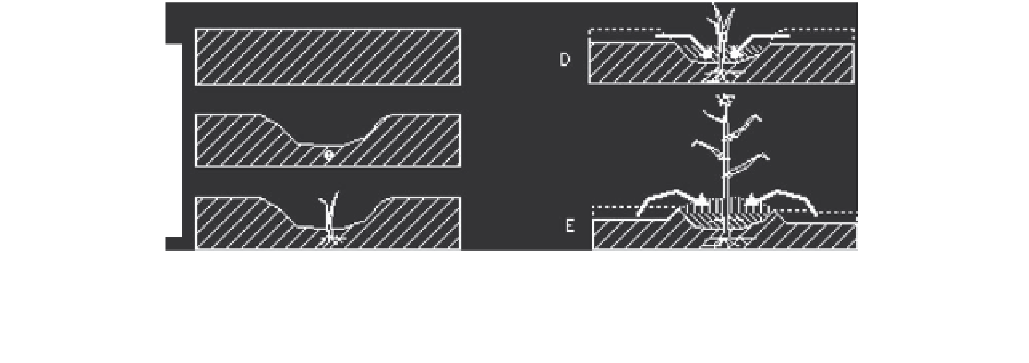Agriculture Reference
In-Depth Information
A
D
B
C
E
FIGURE 7.9
Soil mounding to reduce lodging in corn.
Seeds are planted at the bottoms of furrows (B). After a period of growth
(C), the furrows are filled in with soil from between the rows (D). Soil continues to be mounded around the corn plants as they grow
(E), creating raised rows in which the corn is firmly anchored. The technique also has the advantages of collecting scarce rainfall
for the seed (B) and allowing removal and burial of weeds when the soil between the rows is moved (D and E).
Timing of Planting
becoming especially important for small farm systems and
farmers in the developing world.
Many methods of harnessing or using the wind are
quite simple. For example, the wind can be used to clean
seeds of chaff and leaves (winnowing). The wind can
also be used for drying. Harvested bean plants can be
hung in preparation for thrashing, or fruits such as raisins
or apricots can be laid out to be dried by the wind. A
light breeze aids considerably in removing the boundary
layer of moisture that can form around the plant or plant
product.
Finally, windmills have been used to harness wind
power for a large range of farming activities, from pump-
ing water to generating electricity for use in farming
operations or the farm homestead. Farms in isolated areas,
especially in developing countries, where wind is a con-
stant factor, are especially appropriate candidates for the
use of wind power.
Crop rotations can be used to adjust cropping systems to
wind patterns. Crops prone to wind damage can be planted
during less-windy seasons (assuming that other conditions
are adequate) and followed by wind-tolerant crops. If wind
erosion is more of an issue than wind damage to the crop,
it might be advisable not to open up an entire field to the
wind. Instead, a portion of the field can be planted earlier
to one crop, which can then serve as a barrier for strips
of crops planted at a later time. Another option for pre-
vention of wind erosion is to grow low-residue crops in
protected areas and high-residue crops in more exposed
areas of the farm.
Genetic Varieties Resistant to Wind Effects
A useful way to prevent lodging in grain crops is to
plant a genetic stock that is shorter in stature than usual.
Local farmers on the Isthmus of Tehuantepec in south-
ern Mexico, for example, where wind occurs through-
out the growing season, have selected for corn with a
short stature, thicker stem, and well-developed root
system. These local varieties are highly resistant to
lodging. One of these varieties, called
tuxpeño
, was
used as the genetic stock for breeding with improved
Green Revolution varieties to develop shorter, lodging-
resistant corn with a higher seed load, as well as to
develop varieties more appropriate for harvesting by
mechanized combines.
W
IND
AND
S
USTAINABILITY
Wind is an important component of climate and weather
all over the world. It is also a factor that often has dis-
ruptive or damaging impacts on agroecosystems. By
learning how to design agroecosystems so they are capa-
ble of withstanding and even mitigating the negative
aspects of wind, we take steps toward sustainability. But
the most important steps will come with the development
of design and management strategies that accentuate the
very positive role that air in motion can play in agriculture.
In some ways, these steps may involve a return to the use
of old technologies, such as windbreaks and hedgerows.
Nevertheless, there is a critical need to understand the
ecological basis for using such practices or strategies.
Only then can we develop another measurable component
of sustainability, and as a result, help establish a more
active role for windbreaks, wind turbines, and the man-
agement of daily wind patterns in sustainable farming
systems.
H
ARNESSING
W
IND
We have primarily discussed ways by which a farmer can
manipulate wind in order to take advantage of its positive
effects or to mitigate the negative impacts. But wind has
other uses in farming systems that help contribute to the
larger goal of sustainability. Harnessing the energy of
wind can help reduce external-input and nonrenewable
energy use, especially the burning of fossil fuels. This is

Search WWH ::

Custom Search